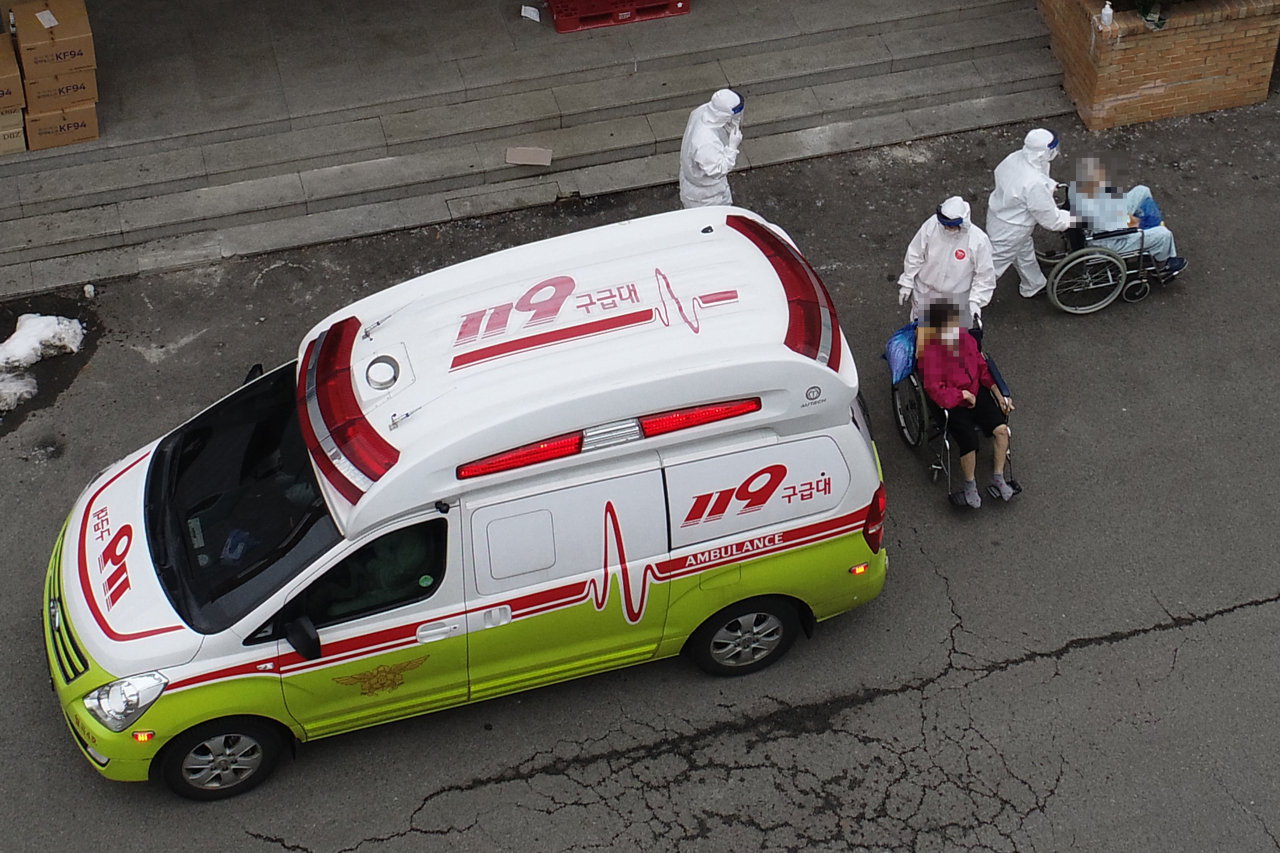 |
Emergency dispatchers over the weekend move residents out of a nursing home in Gwangju. (Yonhap) |
More than 1,000 people in South Korea had lost their lives to COVID-19 as of Monday at midnight.
The Korea Disease Control and Prevention Agency on Tuesday announced 26 more deaths from the previous day, bringing the death toll to 1,007. The country reported its first death from the virus on Feb. 20 last year.
The third surge of the pandemic in Korea is proving to be the deadliest yet. About half of all deaths in the country had taken place between the first day of December and Tuesday. The death rate -- the number of deaths so far divided by the number of cases so far -- was 1.55 percent.
In response to a press request for comment on passing the grim milestone, the KDCA told a virtual briefing that the agency would prioritize medical care for those considered at risk to reduce the incidence of deaths.
“The steep rise in death can be attributed to a series of outbreaks at nursing homes, which are inhabited by vulnerable people,” said Lee Sang-won, a senior official at the agency.
Last month, over 50 people at nursing homes and nursing hospitals across the country died waiting to be transported to hospitals. When a case is discovered at such a facility, all staffers and residents are locked down together until beds open up at hospitals.
The Korean Medical Association, which represents around 130,000 physicians here, offered condolences to the loved ones of those who had died from COVID-19 in a statement Tuesday afternoon.
“Today, Korea’s death toll from the pandemic exceeded 1,000. To the family and friends of those who have passed, we extend our deepest sympathy,” the association said.
“We will continue to keep our place at the front lines of the fight against the pandemic.”
Korea confirmed 715 more cases -- 672 locally transmitted and 43 imported -- on Monday, down 313 from the day prior. The cumulative number of official cases is 64,979. In the last seven days, the number of new cases averaged 915.3 per day.
Despite the drop in the number of infections, deaths and hospitalizations are expected to increase as people older than 60 make up around 30 percent of all cases being detected.
The health authorities don’t know how 27.7 percent of the 6,407 patients diagnosed in the last seven days contracted the virus. Over 2 percent of all those tested yielded positive results, which indicates high transmission in the community.
There are 17,800 patients with active infections who have been put under isolation, of whom 386 are either severely or critically ill. About 75 percent of all intensive care unit beds for COVID-19 patients were full by Monday afternoon.
Correctional facilities and long-term care institutions are currently the sites of the largest active outbreaks.
Six more people tested positive at a detention center in eastern Seoul, with the number of cases there totaling 1,090. At least two of the inmates died while in quarantine at the detention center before they could be taken to a hospital. Nursing hospitals in Seoul’s Guro, Incheon’s Gyeyang and Gwangju’s Gwangsan have all reported outbreaks, with 324 cases identified among residents and staffers to date.
Starting Friday, Korea will require all noncitizens wishing to enter the country to present a negative PCR test result following the discovery of at least 12 cases of the more contagious strain of the virus among recent passengers.
From Dec. 1 to Tuesday, 995 passengers traveling to Korea tested positive for COVID-19. So far, Korea has confirmed 5,539 cases tied to international arrivals.
By Kim Arin (
arin@heraldcorp.com)





![[Exclusive] Hyundai Mobis eyes closer ties with BYD](http://res.heraldm.com/phpwas/restmb_idxmake.php?idx=644&simg=/content/image/2024/11/25/20241125050044_0.jpg)
![[Herald Review] 'Gangnam B-Side' combines social realism with masterful suspense, performance](http://res.heraldm.com/phpwas/restmb_idxmake.php?idx=644&simg=/content/image/2024/11/25/20241125050072_0.jpg)

